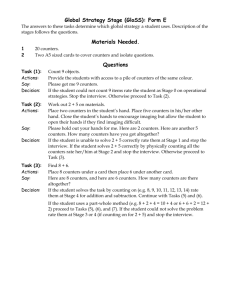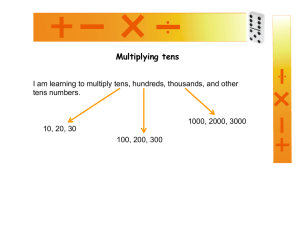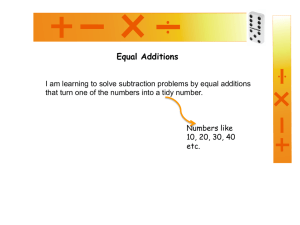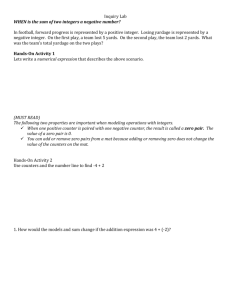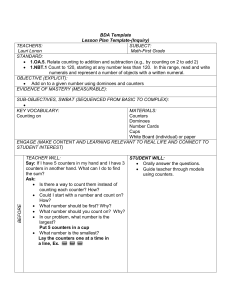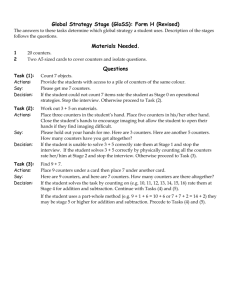Creating Mathematicians
advertisement
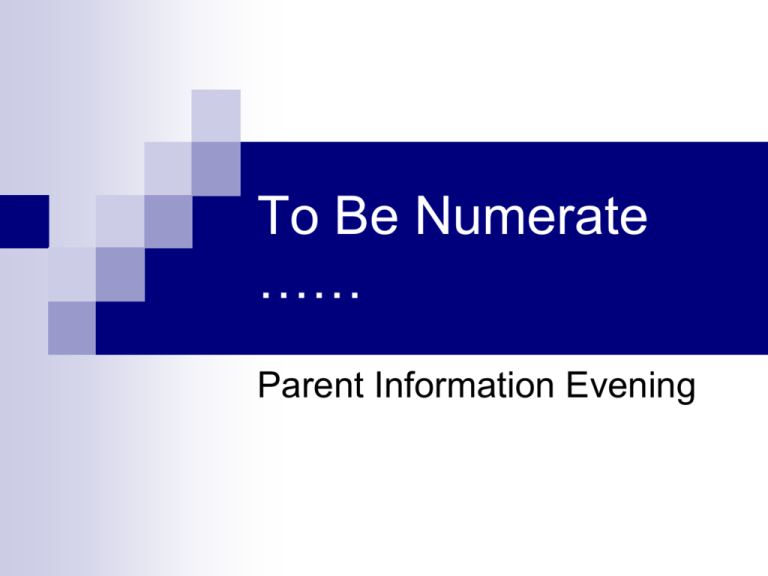
To Be Numerate …… Parent Information Evening Outline Problem Solving Activities How is Mathematics taught now? The New Zealand Numeracy Framework Helpful and practical ideas to support your child’s learning in mathematics. Time to Think!!! Number Strategies Subtraction There are 53 people on the bus. 29 people get off. How many people are now on the bus? Solution 53 – 29 = How did you work it out? What happened in your head? Share your different strategies with the people around you Make sense of these strategies I use place value “53 – 20 = 33. Minus another 9. Split the 9 into 3 and 6. 33- 3 = 30 – 6 = 24 “I use an open number line!” +1 + 29 230 0 +20 +3 50 +1 53 – 29 = 53 I use balancing. 53 – 29 = +1 54 – 30 = 24 “I use tidy numbers: 53 – 30 = 23 plus 1 = 24 “I think of 53 -29 3 – 9 I can’t do so I borrow a ten. 13 – 9 = 4. 4 tens – 2 tens = 2. It’s 24 Number Strategies Addition There are 47 children in the hall. 28 more children arrive. How many are in the school hall now? Solution 47 + 28 = How did you work it out? What happened in your head? Share your different strategies with the people around you. Can you think of any other ways to solve the problem? Make sense of these Strategies “Four rows of ten is 40 and two rows of ten is 20, so 40 + 20 = 60 with 7 and 8 left ! double 7 = 14 plus 1 =15 so there are 75 children” “I use an open number line!” +3 +20 47 47 + 28 = +5 75 “I know that 50 plus 30 is 80 and 3 plus 2 is 5, so 80 - 5 is 75 “ “I use tidy numbers: 50 + 28 = 78 78 - 3 = 75”. “I think of 47 +28 7 plus 8 is 15, so that’s 5 and carry one. 4 plus 2 is 6 plus one more ten is 7. so the answer is 75” Number Strategies Multiplication There are 4 packets of biscuits with 24 cookies in each pack. How many cookies are there altogether? Solution 4 x 24 = How did you work it out? What happened in your head? Share your different strategies with the people around you. How else could this problem be solved? Make sense of these Strategies. “I use tidy numbers: I know 4 x 25 = 100. 100-(1x4) = 96. 4 x 24 = “I know 24 + 24 = 48. 48 + 48 = 96 I used doubling and halving. Double 4 = 8, half 24 = 12. 8 x 12 = 96 “I used place value 4 x 20 = 80. And 4 x 4 = 16. 80 + 16 = 96 “I think of 24 X4 4 x 4 = 16. Put down the 6 and carry the 1. 4 x 2 = 80 + another ten = 90 90+6 = 96 Number Strategies Proportions You can make 21 glasses of lemonade from 28 lemons. How many glasses can you make from twelve lemons? Solution 21:28 ? :12 How did you work it out? What happened in your head? Share your different strategies with the people around you. Can you think of any other ways to solve this problem? Make sense of these Strategies. I like to use a double numberline. 12 ? 28 lemons “21 and 28 are both divisible by 7. It’s 3:4 ? :12 3 x 4 = 12 so 3 x 3 =9 21 lemonade 21:28 ? :12 Numeracy Project Goal “to be numerate is to have the ability and inclination to use mathematics effectively – at home, at work and in the community” Published in Curriculum Update 45: Goals cont. developing multiple flexible thinking strategies mental and oral before written standard vertical forms Make decisions about the smartest strategy to use on any given problem. Challenge children to achieve and develop a positive attitude towards learning mathematics. Developmental Stage Progression The New Zealand Number Framework Numeracy Stages Emergent One to One Counting Count from one on Materials Count from one by Imaging Advanced Counting Early Additive Part-Whole Advanced Additive Part-Whole Advanced Multiplicative Advanced Proportional Counting Strategies Non Counting Strategies Emergent Can you get me 7 counters from the pile please? Movie Clip 1,2,3,5, 8...? The child can not consistently count a collection of objects. One to One Counting Can you get me 7 counters from the pile please? 1,2,3,4, 5,6,7,8. The child can count a set of objects up to ten but can’t join and separate sets like 4 + 3 = Count From One on Materials There are 4 counters and another 3 counters. How many are there altogether? 1,2,3,4, 5,6,7. The child solves the problem by using their fingers or other materials and counts from one. Count From One By Imaging There are 4 counters and another 3 counters. How many are there altogether? Counts in head 1,2,3,4,5,6 ,7,8. The child counts all the objects from one by imaging visual patterns of the objects in their mind. Advanced Counting There are 9 counters under there and another 4 counters under there. How many are there altogether? 9, 10, 11, 12, 13. Counts on The child counts on from the largest number Early Part-Whole There are 9 counters under there and another 6 counters under there. How many are there altogether? “I know that If I take one off the 6 and put it on the 9 it =10. 10 + 5 = 15” The child uses simple strategies to solve addition and subtraction problems mentally Advanced Part-Whole 63 people are on the bus and 39 people get off the bus. How many people are left on the bus? I think tidy numbers would be smartest. 63 – 40 = 23 23 + 1 = 24 The child can select from a wide range of strategies to solve various addition and subtraction problems mentally Advanced Multiplicative There are 28 fruit trees in each aisle of the orchard. There are 6 aisles. How many trees are there altogether? Tidy Numbers would be a smart strategy. 30 x 6 = 180 180 – (2 x 6) = 168 The child can select from a wide range of strategies to solve various multiplication and division problems mentally. Advanced Proportional You can make 9 mittens from 15 balls of wool. How many mittens can you make from 10 balls of wool? I can see that 9:15 are both multiples of 3. I can simplify by ÷3 and get a ratio of 3:5 ?:10 =6 The child can select from a wide range of strategies to solve challenging problems involving, decimals, fraction percentages and ratios. The NZ Numeracy Framework Each Numeracy Stage highlights key knowledge and strategy that a child should know. Strong knowledge is essential for students to broaden their strategies across a full range of numbers. Creates new knowledge through use Strategy Knowledge Provides the foundation for strategies Knowledge and Strategy Knowledge – Number Identification, Number sequence and order, Grouping and place value, basic facts Strategy – Addition and Subtraction, Multiplication and Division, Fraction and Proportions How is maths taught differently now? Assessing what children know. Assess - where each child is at through oral interviewing and questioning Group according to a Childs strategy stage using the New Zealand Number Framework A useful tool - I CAN Sheets Encourage children to self assess (reflect) know and own their next learning steps. Teaching Model and support children understanding using a researched teaching model. Using materials Thinking about what would happen on the materials Working only on numbers Teach to achieve next learning steps. Using Materials Imaging Materials Working only with numbers How can parents help? Developing a child’s knowledge is a key to their success and development in mathematics. Knowledge Building Counting (cars, shells on beach, pegs, run around the house, how many steps you walk, count backwards, start from different numbers) Numbers before and after (Letter boxes, say a number, use a numberline, use number cards, write a number down, ladder game, keyboard numbers, using dice) Identifying numbers (Letter boxes, number plates, speed signs, how many km to go, number cards, combine numbers) Ordering numbers (Number cards, write some numbers down) Knowledge Building Knowing groups to ten (Using ten frames, using fingers, quinary sticks) Basic addition facts to ten (Buttons, ten frames, quinary sticks, fingers) Recalling Doubles (ten frames, fingers, quinary sticks) Quinary Sticks Ten frames The Reality? To become a Part-Whole thinker children need automatic recall of … Facts to Ten Doubles Facts Ten and ….10 + 6 = 16 To Become a Multiplicative thinker children need to be able to recall the x tables Handouts – Support Material Handout - ‘Support your Child Knowledge Ideas’ Website Handout I CAN sheets link

